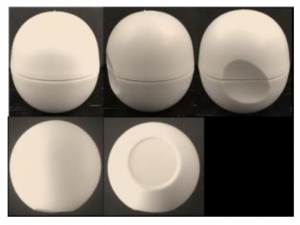The CJUE has recently rejected the admissibility of the appeal filed by Eos Products (hereinafter EOS) against the decision of the General Court (case C-672/21) dated 8 September 2021; considering that the evidence provided was not sufficient to prove distinctiveness, as a result, EOS has not been able to register the egg shape of its lip balm as a three-dimensional trademark.
We proceed to a brief summary of the decisions issued by the various judicial authorities regarding the EOS tridimensional trademark application:
BACKGROUND OF THE DISPUTE
On 6 October 2016, EOS applied to the European Union Intellectual Property Office (EUIPO) for registration of a tridimensional trademark, namely:

The goods for which registration is applied for are the following:
-Class 3: ‘Lip balms [not medicated]; lip cosmetics; lip gloss; lip creams for cosmetic purposes; lip balms [not medicated]; lip care preparations not medicated; lip cosmetics; lip products not for medical use’;
-Class 5: ‘Medicinal preparations for the care of the lips; lip balms for medical use’;
-Class 21: ‘Containers for cosmetics; cosmetic dispensers; cosmetic applicators’.
By decision dated 18 July 2019, the Examiner rejected the application for registration of the above trade mark on the basis of Article 7 (1)(b) of Regulation 2017/1001 on the grounds that the trademark did not deviate significantly from the customary practice in the sector, being confined to shapes and colours that are customary for this type of goods. The examiner considered that the trademark applied for was a rounded shape resembling an egg. The fingerprint as a means of design is perceived as a purely decorative ornament or as a function of opening the packaging and does not allow the consumer to perceive the trademark beyond its purely decorative character and functional effect as proof of origin. In the light of the above, and taking into account that there are no further design or word elements, the trademark applied for as a whole was considered to be devoid of the minimum degree of distinctiveness required.
EOS argued that EUIPO had allowed the registration of comparable signs such as “Labello” for lip balm products (016432288 and 016141111), as well as “EOS” registered tridimensional trademark (015807829). However, the Examiner found that these trademarks did not apply to the present case, as they have, in addition to a tridimensional shape, word elements. These word elements play a role in the examination of distinctiveness.
Furthermore, the Examiner considered that the evidence provided by EOS to establish distinctiveness through use in the European Union was not sufficient, market penetration could not be inferred from only three countries, nor whether the relevant public perceives the trademark as a distinctive sign for the goods of a particular company. Furthermore, none of the evidence submitted by EOS in respect of Class 3 showed the shape of the tridimensional trademark applied for, only samples of lip balms in various colours, the trademark applied for being in black and white; also, without exception, the evidence submitted bore the inscription of the letters ‘eos’, whereas the trademark applied for has no verbal elements.
On 10 September 2019, EOS appealed the Examiner’s decision to the EUIPO; by Decision of 8 June 2020, the Fourth Board of Appeal of EUIPO dismissed the appeal.
The Fourth Board of EUIPO found that the basic shape of the sign is simple and therefore cannot be considered unusual, the light colour and the smooth surface are common in the sector; the other features, such as the thin dividing line between the upper and lower part, the fingerprint-shaped indentation and the flattened lower part, are unremarkable in the overall impression of the sign and are therefore not capable on their own of establishing distinctiveness.
EOS in its appeal argued that its sign had distinctive character given the high number of imitations and counterfeits. However, the Office found that imitations are an indication of commercial success, whereas original distinctiveness must be assessed on the basis of the reproduction of the trademark, independently of actual marketing.
EOS also argued that its products stood out not only because of their spherical shape, but also because of the colouring of the packaging; in response, the Office considered that the colouring of the packaging is related to the launch of the product on the market and as a marketing measure, which are not relevant for the assessment of original distinctiveness. On the basis of the above, the Office concluded that, from the evidence submitted, it could not be established that the claimed shape was perceived by the consumer as an indication of origin; therefore, distinctiveness acquired through use within the meaning of Article 7(3) of the Regulation was not proven.
Against this, EOS appealed to the General Court (Case T-489/20), which upheld EUIPO’s findings in its judgment of 8 September 2021.
First of all, it should be noted that EOS did not put forward any arguments against the finding of lack of distinctive character acquired through use of the trademark applied for within the meaning of Article 7(3) of Regulation No 207/2009, and therefore the General Court did not analyse it.
The General Court considered that the Board of Appeal was correct in finding that lip products can be presented in a wide variety of packaging shapes, including spherical or ovoid packaging, in the form, for example, of a flattened egg, a fruit or a sports ball, and therefore the shape represented in the trademark applied for cannot be considered to deviate significantly from the norms or customs of the sector. It also finds that the relevant public, even with at least an average level of attention, will not, in the absence of any other element, perceive the shape represented by the trademark applied for as indicative of the commercial origin of the goods in question.
Against the General Court’s decision, EOS brought an action before the Court of Justice of the European Union (CJEU), which was dismissed as inadmissible.


 Español
Español Deutsch
Deutsch